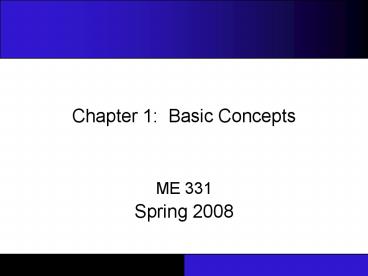Chapter 1: Basic Concepts - PowerPoint PPT Presentation
Title:
Chapter 1: Basic Concepts
Description:
A fluid is a substance in the gaseous or liquid form. Distinction between ... Ma 1 : Hypersonic. Chapter 1: Basic Concepts. ME331 : ThermoFluid Dynamics 11 ... – PowerPoint PPT presentation
Number of Views:63
Avg rating:3.0/5.0
Title: Chapter 1: Basic Concepts
1
Chapter 1 Basic Concepts
- ME 331
- Spring 2008
2
What is a fluid?
- A fluid is a substance in the gaseous or liquid
form - Distinction between solid and fluid?
- Solid can resist an applied shear by deforming.
Stress is proportional to strain - Fluid deforms continuously under applied shear.
Stress is proportional to strain rate
Solid
Fluid
3
What is a fluid?
- Stress is defined as the force per unit area.
- Normal component normal stress
- In a fluid at rest, the normal stress is called
pressure - Tangential component shear stress
4
What is a fluid?
- A liquid takes the shape of the container it is
in and forms a free surface in the presence of
gravity - A gas expands until it encounters the walls of
the container and fills the entire available
space. Gases cannot form a free surface - Gas and vapor are often used as synonymous words
5
What is a fluid?
solid
liquid
gas
6
No-slip condition
- No-slip condition A fluid in direct contact
with a solid sticks' to the surface due to
viscous effects - Responsible for generation of wall shear stress
tw, surface drag D ?tw dA, and the development
of the boundary layer - The fluid property responsible for the no-slip
condition is viscosity - Important boundary condition in formulating
initial boundary value problem (IBVP) for
analytical and computational fluid dynamics
analysis
7
Classification of Flows
- We classify flows as a tool in making simplifying
assumptions to the governing partial-differential
equations, which are known as the Navier-Stokes
equations - Conservation of Mass
- Conservation of Momentum
8
Viscous vs. Inviscid Regions of Flow
- Regions where frictional effects are significant
are called viscous regions. They are usually
close to solid surfaces. - Regions where frictional forces are small
compared to inertial or pressure forces are
called inviscid
9
Internal vs. External Flow
- Internal flows are dominated by the influence of
viscosity throughout the flowfield - For external flows, viscous effects are limited
to the boundary layer and wake.
10
Compressible vs. Incompressible Flow
- A flow is classified as incompressible if the
density remains nearly constant. - Liquid flows are typically incompressible.
- Gas flows are often compressible, especially for
high speeds. - Mach number, Ma V/c is a good indicator of
whether or not compressibility effects are
important. - Ma lt 0.3 Incompressible
- Ma lt 1 Subsonic
- Ma 1 Sonic
- Ma gt 1 Supersonic
- Ma gtgt 1 Hypersonic
11
Laminar vs. Turbulent Flow
- Laminar highly ordered fluid motion with smooth
streamlines. - Turbulent highly disordered fluid motion
characterized by velocity fluctuations and
eddies. - Transitional a flow that contains both laminar
and turbulent regions - Reynolds number, Re rUL/m is the key parameter
in determining whether or not a flow is laminar
or turbulent.
12
Steady vs. Unsteady Flow
- Steady implies no change at a point with time.
Transient terms in N-S equations are zero - Unsteady is the opposite of steady.
- Transient usually describes a starting, or
developing flow. - Periodic refers to a flow which oscillates about
a mean. - Unsteady flows may appear steady if
time-averaged
13
One-, Two-, and Three-Dimensional Flows
- N-S equations are 3D vector equations.
- Velocity vector, U(x,y,z,t) Ux(x,y,z,t),Uy(x,y,z
,t),Uz(x,y,z,t) - Lower dimensional flows reduce complexity of
analytical and computational solution - Change in coordinate system (cylindrical,
spherical, etc.) may facilitate reduction in
order. - Example for fully-developed pipe flow, velocity
V(r) is a function of radius r and pressure p(z)
is a function of distance z along the pipe.
14
System and Control Volume
- A system is defined as a quantity of matter or a
region in space chosen for study. - A closed system consists of a fixed amount of
mass. - An open system, or control volume, is a properly
selected region in space. - We'll discuss control volumes in more detail in
Chapter 6.
15
Dimensions and Units
- Any physical quantity can be characterized by
dimensions. - The magnitudes assigned to dimensions are called
units. - Primary dimensions include mass m, length L,
time t, and temperature T. - Secondary dimensions can be expressed in terms of
primary dimensions and include velocity V,
energy E, and volume V. - Unit systems include English system and the
metric SI (International System). We'll use
both. - Dimensional homogeneity is a valuable tool in
checking for errors. Make sure every term in an
equation has the same units. - Unity conversion ratios are helpful in converting
units. Use them.
16
Accuracy, Precision, and Significant Digits
- Engineers must be aware of three principals that
govern the proper use of numbers. - Accuracy error Value of one reading minus the
true value. Closeness of the average reading to
the true value. Generally associated with
repeatable, fixed errors. - Precision error Value of one reading minus the
average of readings. Is a measure of the
fineness of resolution and repeatability of the
instrument. Generally associated with random
errors. - Significant digits Digits that are relevant
and meaningful. When performing calculations,
the final result is only as precise as the least
precise parameter in the problem. When the
number of significant digits is unknown, the
accepted standard is 3. Use 3 in all homework
and exams.































